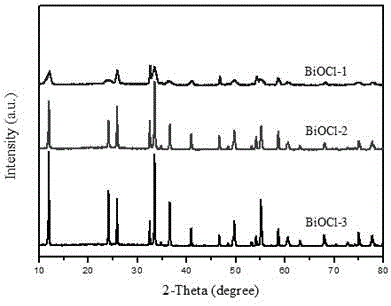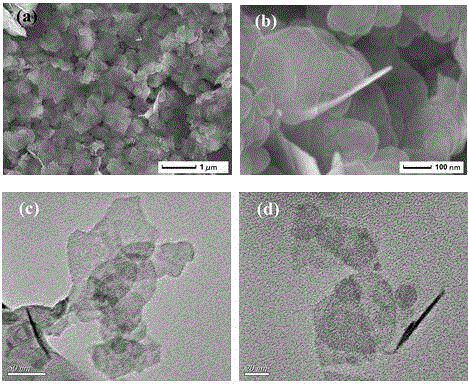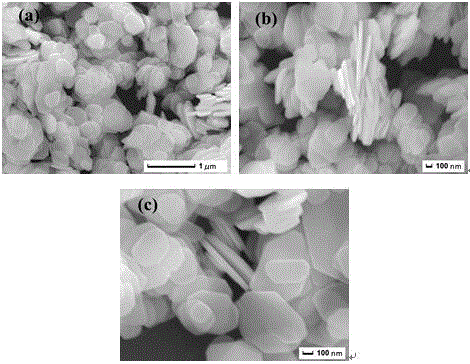Preparation method of ultra-thin BiOCl nano-sheet photocatalyst
A photocatalyst, nanosheet technology, applied in chemical instruments and methods, physical/chemical process catalysts, chemical/physical processes, etc., can solve the problem of low utilization of light energy
- Summary
- Abstract
- Description
- Claims
- Application Information
AI Technical Summary
Problems solved by technology
Method used
Image
Examples
Embodiment 1
[0025] Take 1-hexadecyl-3-methylimidazole chloride as the step of preparing photocatalyst BiOCl nanosheets as chlorine source:
[0026] Take 1 mmol of bismuth nitrate pentahydrate, add 1 mL of glacial acetic acid and 9 mL of deionized water to make solution A, take 1 mmol of 1-hexadecyl-3-methylimidazole chloride and add 10 mL of absolute ethanol to make solution B. Add solution B dropwise to solution A, and stir rapidly. After the dropwise addition, continue to stir for 15-45 minutes, pour the above solution into a high-pressure reactor equipped with a polytetrafluoroethylene liner, at 140-160°C React for 12-24 hours. The obtained product is centrifuged, washed three times with deionized water and absolute ethanol, and finally dried at 30-60°C.
Embodiment 2
[0028] Take 1-hexadecyl-3-methylimidazole chloride as the step of preparing photocatalyst BiOCl nanosheets as chlorine source:
[0029] Take 1 mmol of bismuth nitrate pentahydrate, add 1 mL of glacial acetic acid and 9 mL of deionized water to make solution A, take 1 mmol of 1-hexadecyl-3-methylimidazole chloride and add 10 mL of absolute ethanol to make solution B. Add solution B dropwise to solution A, and stir rapidly. After the dropwise addition, continue stirring for 15 minutes, pour the above solution into a high-pressure reactor equipped with a polytetrafluoroethylene liner, and react at 140°C for 12 hours. The obtained product was centrifuged, washed three times with deionized water and absolute ethanol, and finally dried at 50°C.
Embodiment 3
[0031] Take 1-hexadecyl-3-methylimidazole chloride as the step of preparing photocatalyst BiOCl nanosheets as chlorine source:
[0032] Take 1 mmol of bismuth nitrate pentahydrate, add 1 mL of glacial acetic acid and 9 mL of deionized water to make solution A, take 1 mmol of 1-hexadecyl-3-methylimidazole chloride and add 10 mL of absolute ethanol to make solution B. Add solution B dropwise to solution A, and stir rapidly. After the dropwise addition, continue stirring for 30 minutes, pour the above solution into a high-pressure reactor equipped with a polytetrafluoroethylene liner, and react at 140°C for 18 hours. The obtained product was centrifuged, washed three times with deionized water and absolute ethanol, and finally dried at 50°C.
PUM
| Property | Measurement | Unit |
|---|---|---|
| thickness | aaaaa | aaaaa |
| thickness | aaaaa | aaaaa |
| thickness | aaaaa | aaaaa |
Abstract
Description
Claims
Application Information
 Login to View More
Login to View More - R&D
- Intellectual Property
- Life Sciences
- Materials
- Tech Scout
- Unparalleled Data Quality
- Higher Quality Content
- 60% Fewer Hallucinations
Browse by: Latest US Patents, China's latest patents, Technical Efficacy Thesaurus, Application Domain, Technology Topic, Popular Technical Reports.
© 2025 PatSnap. All rights reserved.Legal|Privacy policy|Modern Slavery Act Transparency Statement|Sitemap|About US| Contact US: help@patsnap.com



